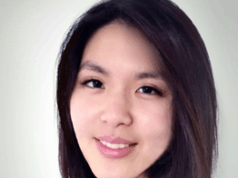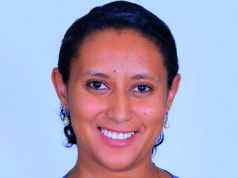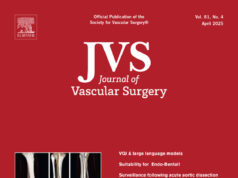
Award-winning vascular resident talks about the science behind her work, which her mentor says is “moving the needle on every front.”
University of Toronto surgeon-scientist trainee Sneha Raju, MD, has been awarded the SVS Foundation Resident Research Award for 2023 for her work on a “new paradigm” of endothelial cell-cell communication and its invaluable implications for atherosclerotic plaque development. Her work delves into the “critical” bidirectional interface that endothelial cells (ECs) inhabit, in the hopes that manipulating the mechanism might lead to mitigation of disease progression.
Created to encourage early-career physicians to become involved in basic science research, the annual award centers on explorations of the biology of vascular disease and potential translational therapies. Abstracts are submitted by the applicant alongside an SVS senior collaborator, and on winning, are given the opportunity to present their research at VAM. Said to be “moving the needle on every front” by her mentor and collaborator Kathryn L. Howe, MD, PhD, at the University of Toronto, Toronto, Canada, Raju is set to present her research during the first plenary—William J. von Liebig Forum session—on Wednesday June 14, 8–8:10 a.m. in Potomac A/B).
The research is founded on a central tenet—ECs can release extracellular vesicle (EV)-encapsulated miRNAs and proteins to mediate cell-cell communication. Seeking to expand on this, Howe and Raju hypothesized that EC-EV release is altered by activation state and drives functional changes in surrounding cells via bidirectional release.
In conversation with VS@VAM prior to her presentation, Raju reflects on how the research was borne out of a deficit in knowledge surrounding plaque burden and its progression. Approaching Howe who runs a laboratory focused on endothelial communication and carotid disease, Raju found that their interests blended, and they began investigating this question through an endothelial and vesicle perspective, specifically looking at the bidirectional interface where these cells communicate.

“The idea in both of our minds,” Howe tells VS@ VAM, “is that atherosclerosis does not form overnight—it is not a single moment in time, it takes decades to form. So, if you envision a cell that has lived at this interface for a time where it is constantly irritated or activated by non-laminar or turbulent flow, you can imagine how it may be constantly sensing and communicating back this distressed environment response.” With this information, Raju alongside Howe investigated what drives atherosclerosis and plaque build-up in target zones, considering what influences shifts in cell activation state from stable to vulnerable to rupture.
These activation states, Raju describes, can be “happy” or “angry”, denoting the either quiescent or inflammatory vesicle packages the EC contains. “We wanted to see how the EC modulates vesicle release in conditions that are quiet and happy—and in conditions where we have made them angry, as is seen in patients who have vascular diseases like atherosclerosis,” Raju outlines. Interestingly, when relevant cells are treated with EC-derived vesicles, they found that vesicles were able to modulate or change conditions in cells found in both the vessel wall and the blood, raising new questions on the mechanism behind this.
“We were the first to show that ECs can load specific cargo and secrete it in both the apical and basolateral directions”, Raju says, their findings uncovering the “critical interface” ECs reside in. “Not only are they able to sense what is going on in the environment, but they are able to change the vesicular cargo” said Raju, which can then induce the happy or angry cell activation states. Importantly, they also found that ECs can polarize vesicle release bidirectionally, which may specifically govern functional changes in circulating and resident vascular cells.
“This has broad-ranging applications” Raju states, “although it builds on a fundamental principle of vascular biology—we know that these ECs are secreting vesicles that are going into the vessel wall and communicating with cells there. If we can find a way to harness and change that communication to make it happier, then we can hopefully circumvent, reverse or rescue some of the negative cell-cell communication happening in disease states to mitigate plaque progression.”
Making continued progress, Raju is interested in exploring this from a biomarker perspective so that she can get ahead of plaque progression before a patient becomes symptomatic. “As vascular surgeons we operate on patients who have symptomatic carotid atherosclerosis which leads to stroke.” However, without a “good biomarker” to indicate plaque progression in asymptomatic patients, predicting and preventing later clinical events can be difficult.
Understanding the communication between ECs and progression to rupture or stroke formulates the translational aspect to Raju’s research, which is a key element in the Resident Research Award’s parameters. To explore this, Raju’s team have been collecting carotid plaques and plasma to see if this information can be corroborated with their patient cohort. From a therapeutic perspective, Raju states, they want to better understand the mechanism by which ECs are releasing vesicles in a basolateral direction and driving the biology of the disease, so that they can design therapeutics or small molecules that can “inhibit or enhance” the mechanism and find ways of reverting it into a quiescent phenotype. “I think we have unearthed a basic biological tenet that can be applied to several vascular pathologies, which is promising,” Raju concludes. “Beyond a vascular surgical viewpoint, it could also be applied to other areas such as cerebral aneurysms or cancer biology.”
On winning the award, Raju reflects on the “motivation and inspiration” gaining this recognition has instilled: “It is great that the committee thought this work deserving of the award, I am very grateful for this international platform to showcase my research and establish international collaborations with fellow vascular surgeons and scientists to advance some of these questions together.”
On her involvement in research projects of the future, Raju details that in the year before she returns to residency, she hopes to dedicate time to the translational side of the current research. “I hope to stay involved in this project as it progresses and develops, and use this skill set to ask vascular biology related questions as a future surgeon-scientist in my own independent lab—that would be the dream.”
Looking ahead to Raju’s presentation at VAM 2023, Howe believes it is an exciting chance to “lift the lid” on the progressions being made in research and “bring this into the space of the clinician.”











